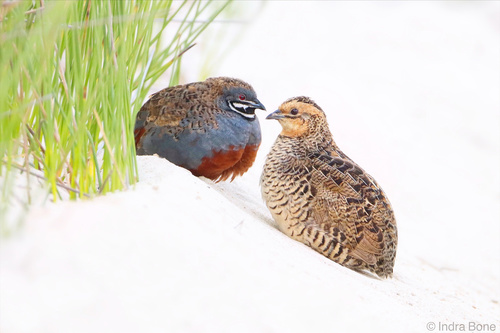
King Quail
The King Quail (*Synoicus chinensis*, formerly *Excalfactoria chinensis*), also known as the Chinese painted quail, or blue-breasted quail, is a small, colorful bird in the Phasianidae family. It's known for its diminutive size and the striking blue and chestnut plumage of the males. It plays a role in its ecosystem as a seed disperser and prey item for larger animals. While not globally threatened, habitat loss in some regions has impacted local populations. It holds no major cultural significance, though it is sometimes kept as an aviary bird.
12.5-14 cm
Length
20-25 cm
Wingspan
Least Concern
Conservation Status
Distribution
The King Quail has a wide distribution, ranging from southeastern Asia (India, Sri Lanka, and southern China) through Southeast Asia to Oceania (including eastern Australia and Tasmania). It does not undertake long-distance migrations but may make local movements in response to food availability.
Lifespan
Typically 3-5 years in the wild, up to 6-8 years in captivity.
King Quail's Habitat
Habitat Types
Grasslands, Scrublands, Agricultural fields (especially rice paddies), Forest edges
Climate Zones
Tropical, Subtropical, Temperate
Adaptations
Their small size and ground-dwelling habits allow them to exploit dense vegetation for cover and food. They are well-camouflaged to avoid predators.
Variations
Several subspecies are recognized, differing slightly in plumage coloration and size. These variations are often linked to geographic isolation.
Appearance
Breeding Plumage
Males have distinct breeding plumage, featuring a blue-gray breast, chestnut belly, and a black-and-white patterned throat. Females are predominantly brown with streaking for camouflage.
Seasonal Feather Changes
There are minimal seasonal variations in plumage beyond the breeding period.
Sex Based Plumage Differences
Highly pronounced. Males are brightly colored, while females are cryptic brown.
Notable Features
Small size, among the smallest quail species., Distinctive black and white 'bib' on male., Short, rounded wings.
Diet and Feeding
Primary Foods
Seeds, Small insects, Green shoots, Small invertebrates
Foraging Behavior
King Quails forage on the ground, scratching and pecking at the soil to uncover seeds and insects. They typically feed in small groups or pairs.
Specializations
Their small beaks are well-suited for picking up small seeds and insects from the ground.
Seasonal Diet Variations
Diet may shift slightly depending on the availability of seeds and insects. During the breeding season, insects may form a larger part of the diet, providing protein for egg-laying and chick growth.
Behavior
Social Structure
King Quails are generally found in pairs or small family groups. They are not highly social outside of the breeding season.
Communication
Soft, high-pitched calls., Whistles., Visual displays (during courtship).
Migration
King Quails are not migratory, although they may make short-distance movements in response to resource availability.
Territorial or Group Behaviors
Males can be territorial during the breeding season, defending a small area around the nest. They are generally not aggressive outside of this period.
Conservation
Threats
Habitat loss (due to agriculture and urbanization), Pesticide use, Hunting (in some regions)
Protection Programs
No specific, large-scale programs are known, but general habitat conservation efforts benefit the species.
Local National Laws
Protected under various wildlife laws in different countries within its range. Check local regulations for specific details.
Population Trend
Stable
Population Estimates
While precise global estimates are difficult, the species is considered relatively common and widespread.
Interesting Facts
They are one of the smallest quail species in the world.
Their small size allows them to thrive in dense vegetation.
The chicks are incredibly small and precocial.
They can run and forage within hours of hatching.
Males have a very distinct facial and chest pattern.
They use for attracting a female partner.
Faqs about King Quail
Can King Quails fly?
Yes, they can fly, but they prefer to run and hide in vegetation. Their flights are typically short and low to the ground.
Are King Quails good pets?
They can be kept as aviary birds, but they require specific care and are not as interactive as some other pet birds.
What is the difference between male and female King Quails?
Males have bright blue and chestnut plumage with a black and white throat pattern, while females are brown and mottled for camouflage.
Copyright @ Nature Style Limited. All Rights Reserved.
 English
English